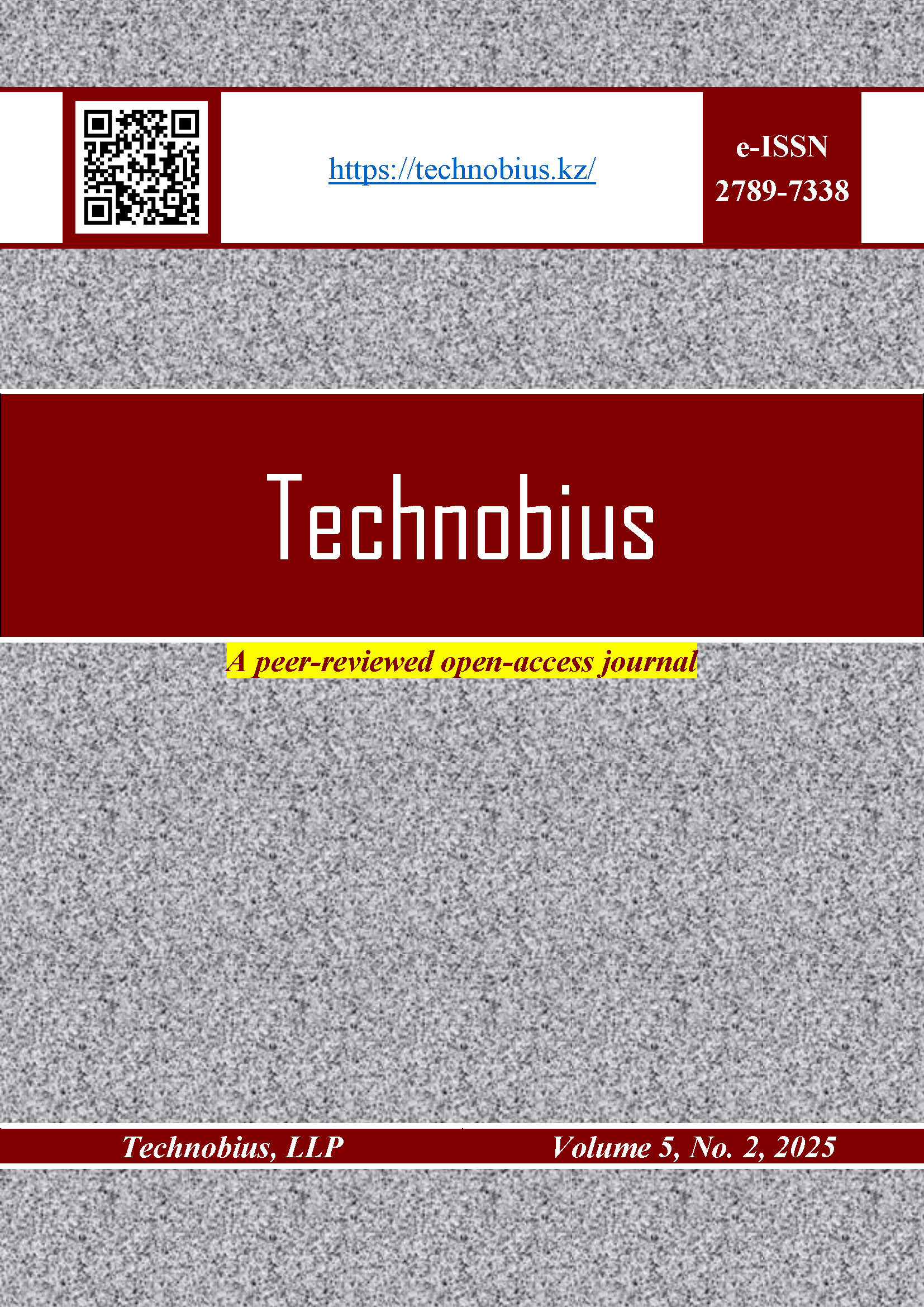Spatial interpolation of the latest Quaternary and older Mesozoic sediment soils
DOI:
https://doi.org/10.54355/tbus/5.2.2025.0077Keywords:
soils, mechanical properties, spatial interpolation, GIS, lithologyAbstract
The paper presents a comparison of three methods of interpolation of engineering-geological parameters of soils: Empirical Bayesian Kriging (EBK), ordinary Kriging, and Inverse Distance Weighting (IDW). The initial data were obtained from bored wells on the territory of the residential complex in Astana city. Interpolation was performed along a horizontal section at a depth of 10 m for the parameters: cohesion, modulus of deformation, and friction angle. The results were visualized as heatmaps. Comparative analysis showed that the EBK 3D method provides a higher degree of detail and robustness to insufficient data density compared to IDW and Kriging, making it the most preferred method for 3D modeling of soil mechanical properties.
Downloads
Metrics
References
R. R. Jones, K. J. W. McCaffrey, R. W. Wilson, and R. E. Holdsworth, “Digital field data acquisition: towards increased quantification of uncertainty during geological mapping,” Geological Society, London, Special Publications, vol. 239, no. 1, pp. 43–56, Jan. 2004, doi: 10.1144/GSL.SP.2004.239.01.04. DOI: https://doi.org/10.1144/GSL.SP.2004.239.01.04
Y. Utepov et al., “Prototyping an integrated IoT-based real-time sewer monitoring system using low-power sensors,” Eastern-European Journal of Enterprise Technologies, vol. 3, no. 5 (123), pp. 6–23, Jun. 2023, doi: 10.15587/1729-4061.2023.283393. DOI: https://doi.org/10.15587/1729-4061.2023.283393
M. Al-Arafat, M. E. Kabir, A. Morshed, and M. A. U. Sunny, “Geotechnical Challenges In Urban Expansion: Addressing Soft Soil, Groundwater, And Subsurface Infrastructure Risks In Mega Cities,” Innovatech Engineering Journal, vol. 1, no. 01, pp. 205–222, Nov. 2024, doi: 10.70937/itej.v1i01.20. DOI: https://doi.org/10.70937/itej.v1i01.20
Zh. S. Nuguzhinov, A. T. Mukhamejanova, D. T. Tokanov, Z. Koishybay, N. Z. Zhumadilova, and M. S. Beketova, “Comprehensive study of the basses and foundations of furnaces No. 61, 63 of the melting shop No. 6 of the Aksu Ferroalloy Plant in connection with the renovation,” in Smart Geotechnics for Smart Societies, London: CRC Press, 2023, pp. 1309–1313. doi: 10.1201/9781003299127-190. DOI: https://doi.org/10.1201/9781003299127-190
A. Z. Zhussupbekov, A. T. Mukhamejanova, and K. A. Abdrakhmanova, “Comprehensive study of the mutual influence of closely erected foundations of reconstructed buildings,” in Smart Geotechnics for Smart Societies, London: CRC Press, 2023, pp. 519–522. doi: 10.1201/9781003299127-63. DOI: https://doi.org/10.1201/9781003299127-63
A. Mukhamejanova, K. Abdrakhmanova, S. Toleubayeva, and A. Kozhas, “Foundation for waterlogged bases with conical void design,” Technobius, vol. 3, no. 1, p. 0031, Feb. 2023, doi: 10.54355/tbus/3.1.2023.0031. DOI: https://doi.org/10.54355/tbus/3.1.2023.0031
F. Jørgensen, R. R. Møller, L. Nebel, N.-P. Jensen, A. V. Christiansen, and P. B. E. Sandersen, “A method for cognitive 3D geological voxel modelling of AEM data,” Bulletin of Engineering Geology and the Environment, vol. 72, no. 3–4, pp. 421–432, Dec. 2013, doi: 10.1007/s10064-013-0487-2. DOI: https://doi.org/10.1007/s10064-013-0487-2
Q. Chen, G. Liu, X. Li, Z. Zhang, and Y. Li, “A corner-point-grid-based voxelization method for the complex geological structure model with folds,” J Vis (Tokyo), vol. 20, no. 4, pp. 875–888, Nov. 2017, doi: 10.1007/s12650-017-0433-7. DOI: https://doi.org/10.1007/s12650-017-0433-7
J. Li, P. Liu, X. Wang, H. Cui, and Y. Ma, “3D geological implicit modeling method of regular voxel splitting based on layered interpolation data,” Sci Rep, vol. 12, no. 1, p. 13840, Aug. 2022, doi: 10.1038/s41598-022-17231-x. DOI: https://doi.org/10.1038/s41598-022-17231-x
C. B. JONES, “Data structures for three-dimensional spatial information systems in geology,” International journal of geographical information systems, vol. 3, no. 1, pp. 15–31, Jan. 1989, doi: 10.1080/02693798908941493. DOI: https://doi.org/10.1080/02693798908941493
H. H. Einstein and G. B. Baecher, “Probabilistic and statistical methods in engineering geology,” Rock Mech Rock Eng, vol. 16, no. 1, pp. 39–72, Feb. 1983, doi: 10.1007/BF01030217. DOI: https://doi.org/10.1007/BF01030217
M. Lepot, J.-B. Aubin, and F. Clemens, “Interpolation in Time Series: An Introductive Overview of Existing Methods, Their Performance Criteria and Uncertainty Assessment,” Water (Basel), vol. 9, no. 10, p. 796, Oct. 2017, doi: 10.3390/w9100796. DOI: https://doi.org/10.3390/w9100796
A. Baghbani, T. Choudhury, S. Costa, and J. Reiner, “Application of artificial intelligence in geotechnical engineering: A state-of-the-art review,” Earth Sci Rev, vol. 228, p. 103991, May 2022, doi: 10.1016/j.earscirev.2022.103991. DOI: https://doi.org/10.1016/j.earscirev.2022.103991
E. S. Utenov, A. T. Mukhamedzhanova, and S. K. Abildin, “Concerning the use of soil deformation modulus in geotechnical design,” in Geotechnics Fundamentals and Applications in Construction: New Materials, Structures, Technologies and Calculations, CRC Press, 2019, pp. 451–456. doi: 10.1201/9780429058882-86. DOI: https://doi.org/10.1201/9780429058882-86
M. Dong, C. Neukum, H. Hu, and R. Azzam, “Real 3D geotechnical modeling in engineering geology: a case study from the inner city of Aachen, Germany,” Bulletin of Engineering Geology and the Environment, vol. 74, no. 2, pp. 281–300, May 2015, doi: 10.1007/s10064-014-0640-6. DOI: https://doi.org/10.1007/s10064-014-0640-6
J. Li and A. D. Heap, “Spatial interpolation methods applied in the environmental sciences: A review,” Environmental Modelling & Software, vol. 53, pp. 173–189, Mar. 2014, doi: 10.1016/j.envsoft.2013.12.008. DOI: https://doi.org/10.1016/j.envsoft.2013.12.008
A. Mukhamejanova et al., “Toward the use of an intermediate value of the modulus of deformation of soils in geotechnical design,” E3S Web of Conferences, vol. 559, p. 01008, Aug. 2024, doi: 10.1051/e3sconf/202455901008. DOI: https://doi.org/10.1051/e3sconf/202455901008
J. Shang, L. J. West, S. R. Hencher, and Z. Zhao, “Geological discontinuity persistence: Implications and quantification,” Eng Geol, vol. 241, pp. 41–54, Jul. 2018, doi: 10.1016/j.enggeo.2018.05.010. DOI: https://doi.org/10.1016/j.enggeo.2018.05.010
A. Aldungarova, T. Muzdybayeva, A. Mukhamejanova, N. Alibekova, K. Moskalova, and S. Karaulov, “Examining intermediate soil properties variability through spatial interpolation methods in GIS,” Technobius, vol. 4, no. 3, p. 0062, Sep. 2024, doi: 10.54355/tbus/4.3.2024.0062. DOI: https://doi.org/10.54355/tbus/4.3.2024.0062
A. Aldungarova, A. Mukhamejanova, N. Alibekova, and A. Aniskin, “Ways to address the construction of new buildings in old urban areas,” Technobius, vol. 3, no. 4, p. 0048, Dec. 2023, doi: 10.54355/tbus/3.4.2023.0048. DOI: https://doi.org/10.54355/tbus/3.4.2023.0048
GISGeography, “Inverse Distance Weighting (IDW) Interpolation,” GIS Analysis. Accessed: Aug. 25, 2019. [Online]. Available: https://gisgeography.com/inverse-distance-weighting-idw-interpolation/
A. Anand, P. Singh, P. K. Srivastava, and M. Gupta, “GIS-based analysis for soil moisture estimation via kriging with external drift,” in Agricultural Water Management, Elsevier, 2021, pp. 391–408. doi: 10.1016/B978-0-12-812362-1.00019-9. DOI: https://doi.org/10.1016/B978-0-12-812362-1.00019-9
K. Krivoruchko, “Empirical Bayesian Kriging: Implemented in ArcGIS Geostatistical Analyst,” ArcUser, vol. 15, no. 4, pp. 6–10, 2012.
Published
How to Cite
License
Copyright (c) 2025 Akmaral Yeleussinova, Nurgul Shakirova, Nurgul Alibekova, Sabit Karaulov

This work is licensed under a Creative Commons Attribution-NonCommercial 4.0 International License.
Funding data
-
Ministry of Education and Science of the Republic of Kazakhstan
Grant numbers AP19676116








